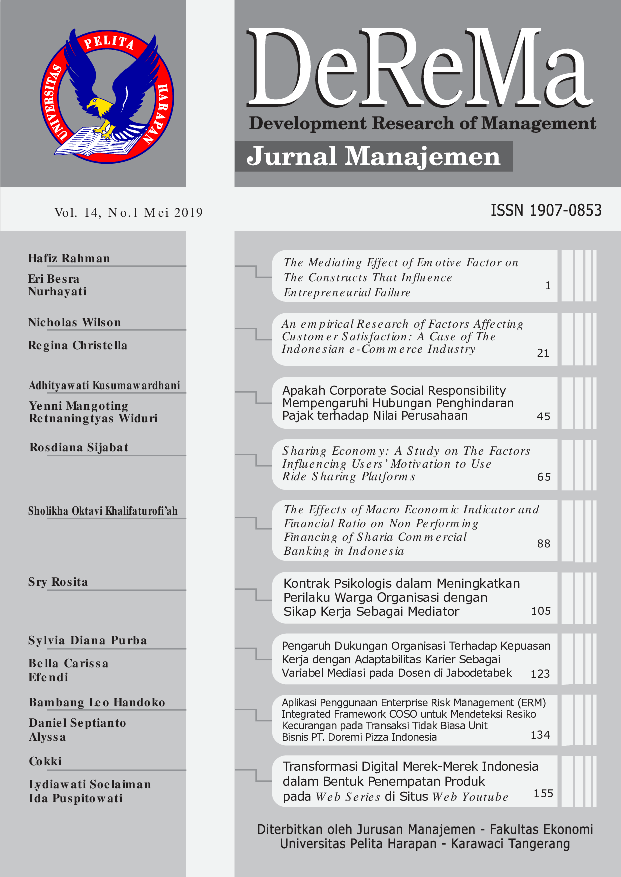Aplikasi Penggunaan Enterprise Risk Management (ERM) Integrated Framework Coso Untuk Mendeteksi Risiko Kecurangan Pada Transaksi Tidak Biasa Unit Bisnis Pt. Doremi Pizza Indonesia [Application of Integrated Enterprise Risk Management (ERM) COSO Framework to Detect Fraud Risk in Unusual Transactions at PT. Doremi Pizza, Indonesia]
DOI:
https://doi.org/10.19166/derema.v14i1.1181Schlagworte:
fraud, audit, Enterprise Risk ManagementAbstract
This research is a case study conducted on food and beverage company in Jakarta that aims to explain the function of Enterprise Risk Management (ERM), describes the company's internal control and formulates the audit tool in accordance with the case. The research method is literature and field study. The results showed that the company has done a good control but not yet efficient in detecting fraud. Companies are advised to conduct store audits more regularly, evaluating standard operating procedures (SOP) on unusual transaction, limiting the number of unusual transaction, verifying and validating practice of unusual transaction, and develop software to detect unusual transaction and fraud occurring in store to reduce the possibility of fraud may occur.
Bahasa Indonesia Abstrak: Penelitian ini adalah penelitian studi kasus yang dilakukan pada perusahaan food and beverage di Jakarta yang bertujuan untuk menjelaskan fungsi Enterprise Risk Management (ERM), menjelaskan pengendalian internal perusahaan dan merumuskan alat audit sesuai dengan kasus yang terjadi. Metode penelitian adalah studi kepustakaan dan studi lapangan. Hasil penelitian menunjukkan bahwa perusahaan telah melakukan pengendalian yang baik namun belum efisien dalam mendeteksi kecurangan. Perusahaan disarankan untuk melakukan audit toko dengan lebih rutin, evaluasi terhadap prosedur standar opersional atau standard operating procedures (SOP) mengenai transaksi tidak biasa, memberikan batasan jumlah transaksi tidak biasa, melakukan verifikasi dan validasi terhadap praktik transaksi tidak biasa, serta mengembangkan software untuk dapat mendeteksi transaksi tidak biasa dan kecurangan yang terjadi pada gerai toko agar dapat mengurangi tindak kecurangan yang dapat terjadi.
Literaturhinweise
AbuShanab, E., Pearson, M., & Setterstorm, A. (2005). Internet Banking and Customers ’ Acceptance in Jordan : The Unified Model ’ s Perspective Internet Banking and Customers ’ Acceptance in Jordan : The Unified Model ’ s Perspective Internet Banking and Customers ’ Acceptance Jordan : The Unified Model ’ s. Doctoral Thesis, 26(April 2010), 493-524. https://doi.org/10.1073/pnas.0703993104
Albrecht, C., Holland, D., Malagueño, R., Dolan, S., & Tzafrir, S. (2015). The Role of Power in Financial Statement Fraud Schemes. Journal of Business Ethics, 131(4), 803-813. https://doi.org/10.1007/s10551-013-2019-1
Arens, A., Elder, R., Beasley, M. S., & Hogan, C. E. (2016). Auditing and Assurance Service (16th ed.). Boston, MA: Pearson.
Aris, N. A., Maznah, S., Arif, M., Othman, R., & Zain, M. M. (2015). Fraudulent Financial Statement Detection Using Statistical Techniques: The Case Of Small Medium Automotive Enterprise. Journal of Applied Business Research, 31(4), 1469-1478. https://doi.org/10.19030/jabr.v31i4.9330
Boyle, D. M., DeZoort, F. T., & Hermanson, D. R. (2015). The effect of alternative fraud model use on auditors’ fraud risk judgments. Journal of Accounting and Public Policy, 34(6), 578-596. https://doi.org/10.1016/j.jaccpubpol.2015.05.006
Chiu, C., Chen, S., & Chen, C. (2017). An Integrated Perspective of TOE Framework and Innovation Diffusion in Broadband Mobile Applications Adoption by Enterprises. International Journal of Management, Economics and Social Sciences, 6(1), 14-39.
Cullen, K. (2018). Development of Security Risk Assessment in an IT and Business Consulting and Outsourcing Company.
Curtis, P., & Carey, M. (2012). Thought Leadership in ERM: Risks Assessment in Practice. Committee of Sponsoring Organizations of the Treadway Commission (COSO), (October), 1-19.
Fahdiansyah, R., & Anas, A. S. (2018). Teknologi Informasi Sebagai Penunjang Perkembangan Sistem. Simposium Nasional Teknologi Terapan (SNTT), 5, 246-253.
Handoko, B., Anwar, S., Siswanto, H., Amir, M. F., & Pribadi, R. (2015). Building an in-house CMMS to simplify maintenance management in an oil and gas company. In Society of Petroleum Engineers - SPE/IATMI Asia Pacific Oil and Gas Conference and Exhibition, APOGCE 2015. https://doi.org/10.2118/176237-MS
Hopper, M.J., & Pornelli, C. M. (2010). Deterring and Detecting Financial Reporting Fraud; A platform for action, (October), 55. Retrieved from http://www.TheCAQ.org
IIA -The Institute of Internal Auditors. (2016). International standards for the professional practice of internal auditing. Retrieved from https://Na.Theiia.Org/Standards-Guidance/Public%20Documents/IPPF-Standards-2017.Pdf
Indarto, S. L., & Ghozali, I. (2016). Fraud Diamond: Detection Analysis on the Fraudulent Financial Reporting. Risk Governance and Control: Financial Markets & Institutions, 6(4), 116-123. https://doi.org/10.22495/rcgv6i4c1art1
Kassem, R., & Higson, A. (2012). The New Fraud Triangle Model. Journal of Emerging Trends in Economics and Management Sciences, 3(3), 191-195. https://doi.org/10.1093/humrep/dep064
Kim, H. J., Mannino, M., & Nieschwietz, R. J. (2009). Information technology acceptance in the internal audit profession: Impact of technology features and complexity. International Journal of Accounting Information Systems, 10(4), 214-228. https://doi.org/10.1016/j.accinf.2009.09.001
KPMG. (2013). COSO - Internal Control / Integrated Framework Executive Summary. Mayangsari, S., & Wandanarum, P. (2013). Auditing : Pendekatan Sektor Publik dan Privat. Jakarta: Media Bangsa.
Moeller, R. R. (2011). COSO enterprise risk management: Establishing effective governance, risk, and compliance processes (2nd ed.). US: John Wiley & Sons, Inc. https://doi.org/10.1002/9781118269145
Munteanu, V., Copcinschi, L., Luschi, C., & Lăceanu, A. (2016). Knowledge Horizons -Economics Internal Audit - Determinant Factor In Preventing And Detecting Fraud Related Activity To Public Entities Financial Accounting. Knowledge Horizons -Economics, 9(1), 55-63.
Ngai, E. W. T., Hu, Y., Wong, Y. H., Chen, Y., & Sun, X. (2011). The application of data mining techniques in financial fraud detection: A classification framework and an academic review of literature. Decision Support Systems, 50(3), 559-569. https://doi.org/10.1016/j.dss.2010.08.006
Richhariya Bits, P., Prashant, B., & Singh, K. (2012). A Survey on Financial Fraud Detection Methodologies. International Journal of Computer Applications, 45(22), 975-8887. https://doi.org/10.5120/7080-9373
Robertson, J. (2010). Auditing for Fraud Detection. California: Professional Education Services, LP.
Santosa, B. (2009). Manajemen Proyek. In Manajemen Proyek (pp. 191-206). Yogyakarta: Graha Ilmu.
Silverstone, H., & Sheetz, M. (2009). Forensic Auditing and Fraud Investigation for Non-Experts. https://doi.org/10.1002%2F9781119200635
Singh, P., & Singh, M. (2015). Fraud Detection by Monitoring Customer Behavior and Activities. International Journal of Computer Applications, 111(11), 23-32. https://doi.org/10.5120/19584-1340
Venkatesh, V., & Bala, H. (2012). Adoption and Impacts of Interorganizational Business Process Standards: Role of Partnering Synergy. Information Systems Research, 23(4), 1131-1157. https://doi.org/10.1287/isre.1110.0404
Downloads
Veröffentlicht
Ausgabe
Rubrik
Lizenz
Authors who publish with this journal agree to the following terms:
1) Authors retain copyright and grant the journal right of first publication with the work simultaneously licensed under a Creative Commons Attribution License (CC-BY-SA 4.0) that allows others to share the work with an acknowledgement of the work's authorship and initial publication in this journal.
2) Authors are able to enter into separate, additional contractual arrangements for the non-exclusive distribution of the journal's published version of the work (e.g., post it to an institutional repository or publish it in a book), with an acknowledgement of its initial publication in this journal.
3) Authors are permitted and encouraged to post their work online (e.g., in institutional repositories or on their website). The final published PDF should be used and bibliographic details that credit the publication in this journal should be included.





